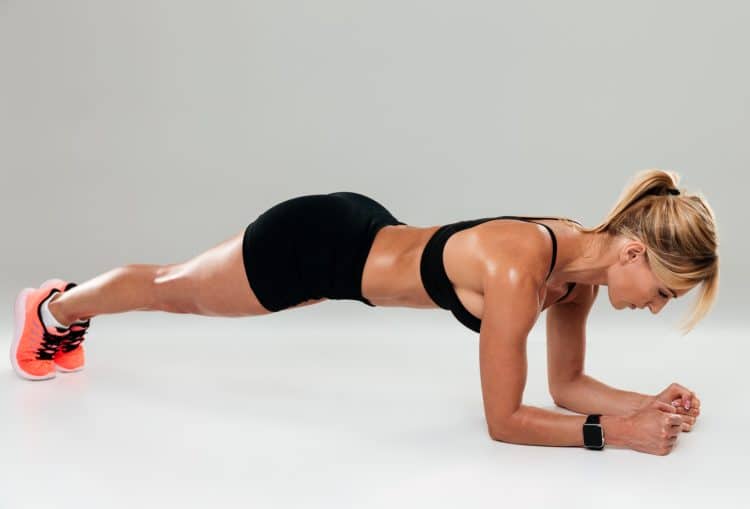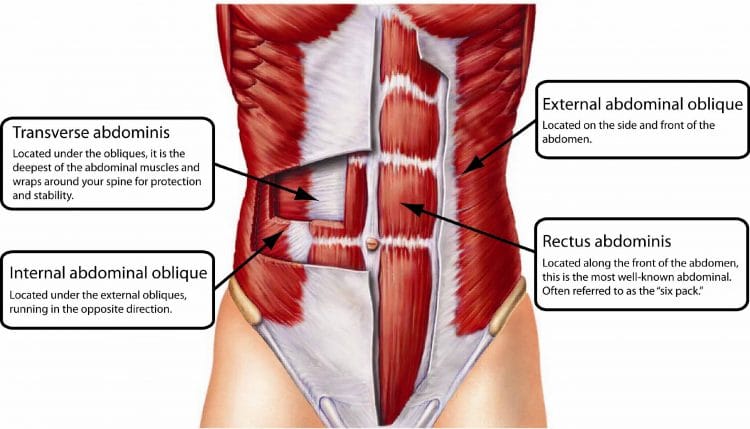The front plank is arguably one of the most popular abs exercises around. Planks are an isometric exercise, which means that even though your muscles are generating lots of force and tension, there is no significant movement. This makes planks very spine-friendly.
However, while planks ARE a fantastic exercise, they’re not exactly exciting. And once you can do more than a couple of minutes, planks can become downright boring.
 Did you know that the current world record for planks is over eight hours? Impressive for sure, but, seriously, what a snooze-fest!
Did you know that the current world record for planks is over eight hours? Impressive for sure, but, seriously, what a snooze-fest!
Rather than planking for longer and longer, this workout combines five different plank variations to hit your core from multiple angles and deliver the results you want in just five minutes a day!
Planking Anatomy
While you don’t need to know the names of the muscles you’ll be training during this workout, we know that some people enjoy reading and learning about anatomy and physiology.
So, to that end, these are the primary muscles you’re going to be working:

Rectus abdominis
Often called the abs for short, this muscle is located on the front of your abdomen. If you are lean enough, the rectus abdominus is the muscle that forms a six-pack. The functions of the rectus abdominis are flexion and lateral flexion of your spine and compression of the abdominal cavity.
Obliques
Located on the side of your waist, the obliques are responsible for the rotation and lateral flexion of your spine. There are two groups of oblique muscles, internal and external, and they always work together.
Transverse abdominis
Encircling your midsection like a muscular weightlifting belt, the transverse abdominis helps stabilize your lumbar spine. It’s strongly involved in every type of planking exercise. Strengthening the TVA can help prevent and alleviate lower back pain and could give you a smaller, tighter waist (1).
Erector spinae
Erector spinae is the collective name for the muscles of your lower back. They’re responsible for lateral flexion and extension of your spine. During planks, the erector spinae help to hold your body straight. There is also a plank exercise in this workout that specifically targets these muscles.
The Five-Minute Plank Workout for Ripped Abs
Five minutes of core training a day might not sound like a lot but, with the right choice of exercises, it may be enough to help you sculpt the midsection of your dreams!

For this workout, you’re going to do one set of five different planking variations to total five minutes. The exercises are:
- Standing plank walkout
- Alternating T-plank
- Bear crawl plank
- Bench plank mountain climber
- High reverse plank
Each plank variation hits your abs from a different direction to ensure that no part of your core is left untrained.
Do this workout five days a week for five weeks, increasing the duration of each exercise as shown below:
| No | Week | Details |
| 1 | Week 1 | 40 seconds work/20 seconds between exercises |
| 2 | Week 2 | 45 seconds work/15 seconds between exercises |
| 3 | Week 3 | 50 seconds work/10 seconds between exercises |
| 4 | Week 4 | 55 seconds work/5 seconds between exercises |
| 5 | Week 5 | 60 seconds work/0 seconds between exercises |
Simply do the first exercise for the allotted time, rest as prescribed, and then do the next exercise. Over the course of five weeks, the work periods get longer, and the rests decrease until, during the fifth week, you are working for five minutes non-stop.
You can do this plank workout every weekday, taking weekends off, or do three days on, rest a day, and then do another two workouts before resting again. Ultimately, it’s up to you. So long as you work out five days out of every seven, you’ll be good to go!
Exercise Instructions
There are two ways to do any exercise – the right way and the wrong way. The right way makes the best use of your training time and is generally safest. The wrong way provides a less effective workout and could also increase your risk of injury.
Follow these instructions to make sure you do each of the exercises in your workout as safe and productive as possible!
1. Standing Plank Walkout
Most planking exercises are very static. This one’s a little different as it involves plenty of movement. However, this movement is what makes the plank walkout such an effective exercise. It’s also good for developing shoulder stability and chest and triceps endurance.
How to do it:
- Stand with your feet together and your arms by your sides. Brace your abs and pull your shoulders down and back. Bend your knees slightly.
- Hinging forward from your hips, place your hands on the floor in front of your feet. Bend your knees as much as necessary to do this.
- Keeping your abs tight, walk your hands forward and into the push-up position. Walk your hands a little further forward to make this exercise more challenging.
- Walk your hands back toward your feet and then stand up.
- That’s one rep – keep going!
2. Alternating T-plank
This planking variation increases oblique or waist engagement as well as working your rectus abdominus. Balancing on one arm will also improve shoulder and triceps strength.
How to do it:
- Adopt the high plank or push-up position. Your arms should be straight with your hands pointing forward and roughly shoulder-width apart. Brace your abs and pull your shoulders down and back.
- Shift your weight onto one arm and rotate your shoulders and hips. Extend your non-weight-bearing arm up to the ceiling to form a T-shape.
- Return your hands to the floor, swap arms, and repeat on the other side.
- Continue alternating sides for the prescribed duration.
3. Bear Crawl Plank
While there is nothing wrong with regular planks, you can have too much of a good thing. Do them often enough, and even the mighty plank will lose some of its effect. Like regular planks, the bear crawl plank works your core. Still, they’re different enough to provide some much-needed variety to your midsection workouts.
How to do it:
- Kneel on all fours with your hands directly under your shoulders and your knees under your hips. Pull your toes up and press the balls of your feet into the floor. Brace your abs, pull your shoulders down and back, and rotate your arms inward to engage your lats.
- Lift your knees a few inches off the floor while keeping your hips level with your shoulders.
- Maintain this position for the required duration.
Related: How to Do the Bear Plank for Rock Solid Core
4. Bench Plank Mountain Climber
The bench plank mountain climber involves moving your legs while stabilizing your core. This increases midsection muscle engagement to produce a more challenging workout. Rest your forearms on a weight training bench or sturdy chair.
You can also do this exercise in the high plank position, i.e., with straight arms, but your triceps and shoulders may feel a little tired after the last exercise. Doing it on your elbows means you are free to focus more on working your abs.
How to do it:
- Place your forearms on an exercise bench and walk your feet out and back into the plank position. Brace your abs.
- Bend one leg and pull your knee up and into your elbow/the edge of the bench.
- Extend your leg, swap sides, and repeat.
- Continue alternating legs for the allotted duration.
5. High Reverse Plank
This exercise works your core, glutes, hamstrings, and lower back. These muscles are essential for posture and structural balance. If you only train the muscles on the front of your abdomen, you may end up hunched over, and your abs will bow outward.
Working the muscles on the back of your body will hold you upright and make your abs look instantly flatter. This exercise also provides a welcome stretch for those hard-working abs muscles.
How to do it:
- Sit on the floor with your legs straight. Place your hands on the floor a few inches behind your hips, fingers pointing backward.
- Keeping your elbows extended, lift your hips off the floor, so your body is straight.
- Hold this position for the specified duration.
- You can also do this exercise while resting on your elbows. Some exercisers may find this variation more comfortable.
Related: High Reverse Plank
Tips for Shredded Abs
As effective as this workout is, you’ll probably need more than five minutes of exercise a day to get shredded abs. Combine our planking workout with the following nutrition and training tips for better results.
Create a Calorie Deficit

Getting shredded abs invariably means shedding the unwanted body fat that’s currently obscuring them. So, you’re going to have to eat a little less to reveal your hard-won six-pack!
Before jumping on the latest fad diet trend, understand that losing fat is best done slowly and sensibly; you don’t need to starve yourself.
Instead, calculate your Total Daily Energy Expenditure and then subtract 300-500 calories from that number to determine how many calories you need to eat to lose fat.
Using this method, you should lose 1-2 pounds of fat per week while preserving muscle mass. This is arguably the best way to lose fat without going on a very restrictive and unpleasant diet.
Related: Calorie Deficit Calculator
Eat for Fullness

Eating less can lead to hunger and cravings. You can minimize both by sticking to the suggested 300-500 calorie deficit. This is enough to trigger fat loss, but not so much that you’ll feel deprived or starving. That said, you can make things easier by eating for fullness.
That means:
- Eating protein at every meal
- Filling up on high fiber veggies
- Eating healthy fats with most meals
- Cutting down on sugar
- Eating healthy snacks between meals
- Eating slower and more mindfully
Eat Healthily
While you could lose weight by eating junk food, it’s not a good idea. Junk food is invariably high in sugar, fat, and salt and low in essential nutrients like vitamins and minerals. Your body needs more than just calories to sustain itself; it requires an abundance of micronutrients too.
A healthy diet leads to a healthier organism (you!), and the healthier you are, the better your body will be able to burn fat. Also, you will find that you have more energy for exercise and recover better from your workouts when you eat less junk food.
Try to eat less processed food and more natural food. Natural foods are usually lower in calories, more filling, and higher in nutrients than junk food.
Combine Your Abs Workout with a Full-body Training Program
It’s very hard to develop one muscle group without improving the rest of your body. For best results, combine our Five-Minute Planking Workout for Shredded Abs with a full-body strength training workout.
Good options include:
- Beginner’s Bodybuilding Program
- Equipment-Free Bodybuilding Workout
- Beginner’s Muscle Tone Workout Plan: How to Get Toned
- The Ultimate Push-Pull-Legs Workout Guide
- One Kettlebell and Bodyweight Full-Body Workout
Do Some Cardio
You’ll get shredded abs sooner if you incorporate some cardio into your workout routine. Cardio burns calories and fat. You can do Low-intensity Steady State (LISS) cardio or High-Intensity Interval Training (HIIT) as preferred. Aim for 3-4 sessions of 20-30 minutes a week.
Read more about the advantages and disadvantages of different cardio training methods here.
Supplement Wisely

While you don’t need to use supplements to lose fat and get shredded abs, they can help make your workouts and diet a little more effective.
Good options include:
Wrapping Up
Getting shredded abs will have a huge impact on how you look and feel. However, losing the fat around your abdomen to reveal your six-pack is not just good for your appearance; it’s good for your health too.
Excess abdominal fat is inextricably linked to a wide range of medical and health issues, including heart disease, high blood pressure, insulin resistance and diabetes, and some types of cancer.
So, commit to getting shredded abs, and you’ll not only sculpt a midsection you can be proud of, but you’ll also improve your health and could even live longer!
References:
1 – PubMed: Comparison of the Effects of Hollowing and Bracing Exercises on Cross-sectional Areas of Abdominal Muscles in Middle-aged Women ncbi.nlm.nih.gov


